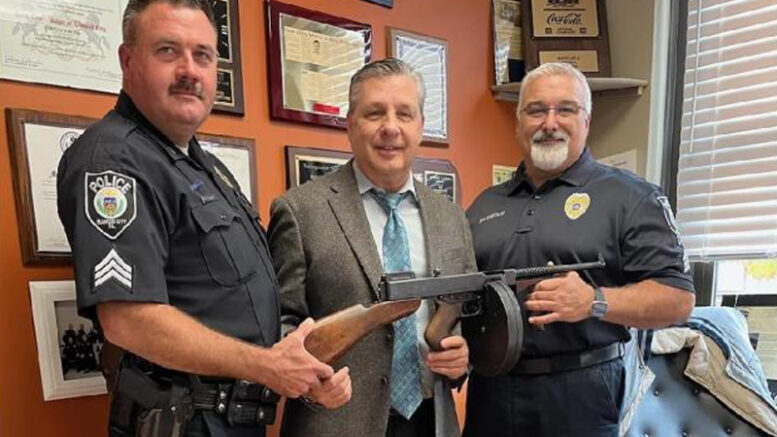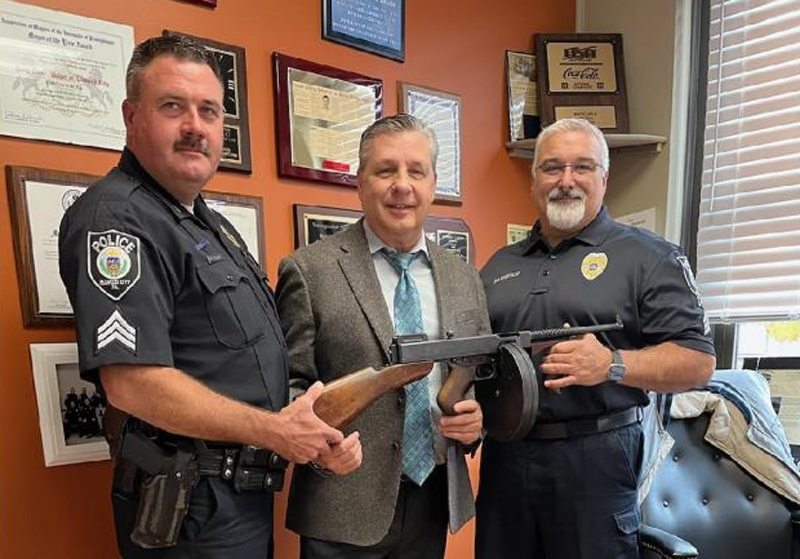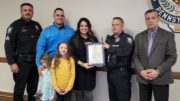The classic image of a Thompson submachine gun with its distinctive drum magazine was made popular by romanticized movies and TV shows like “The Untouchables” depicting Prohibition-era gangsters using the euphemistic “Chicago typewriter” in gangland drive-by shootings. This is the image most people have of a Thompson. Few of us envision a lone Ellwood City Police officer using the iconic weapon against criminals at the end of the Lincoln High School-Veterans Bridge on 5th Street.
The story of that very occurrence is wonderfully told by Robert Barensfeld in his 1995 essay written for the Ellwood City Area Historical Society entitled:“The Great Shootout in Ellwood City in 1941.” In his well-written article, available for perusal at the History Center at 310 5th Street, Barensfeld details the September 19, 1941 heroics of former Ellwood City Police Chief Ernest Hartman in stopping the progress of three Harrisville bank robbers as they tried to escape from a bank heist by taking back roads via Wampum and West Pittsburg through Ellwood City. They did not count on a determined police officer with a Thompson submachine gun setting up a roadblock at the north end of the bridge.
As Barensfeld tells it:
Ellwood City Chief of Police, Ernest Hartman, took the phone call [about the bank robbery] and hurriedly grabbed the .45 cal. Thompson sub-machine gun from its rack and leaped into his patrol car. He drove to the North end of the Fifth Street Bridge where the Wampum Road intersects the bridge. He parked his car along the curb…not knowing for certain that the bandits were headed into Ellwood City. Suddenly, he saw the bandits’ car approach.
When the bandits drew and fired pistols to resist Chief Hartman’s order to surrender, he sprang into action, firing his “Tommy gun” in full automatic mode. All three criminals were hit by Hartman’s barrage.
Although they were able to avoid capture by Chief Hartman, the wounds he inflicted caused them to wreck their getaway car a few miles outside of the Borough on River Road, which in 1941 was unpaved. An off-duty police officer, Edward Shaffer, and a store clerk, James Pasta, had pursued the miscreants in Pasta’s car. They caught up to the robbers as they tried to remove their severely wounded partner from their bullet riddled, wrecked car to a car they commandeered from Angelo DeCarbo and Laura Kash who happened to be heading toward Ellwood at the time.
In the subsequent encounter, Pasta wrestled a rifle from one of the robbers and fatally wounded him while Shaffer, aided by DeCarbo and Kash, subdued the remaining man by beating him with a wrench. In the incident, two of the bandits were killed and one was captured. After recovering in the hospital, he was tried, convicted, and sent to prison. Hartman, Pasta, Shaffer, DeCarbo and Kash were hailed as local heroes.
A Brief History of the Thompson Submachinegun*
In 1916, the inventor of the “Tommy gun,” Brigadier General John Thompson, along with his son, Marcellus, formed the Auto Ordnance Corporation, a company that developed the firearm for American soldiers to be used as a trench clearing weapon to break the stalemate during World War 1. The term “submachine gun” refers to the hand-held firearm’s use of .45 Caliber ACP pistol ammunition rather than the higher velocity rifle ammunition of a heavy machine gun. However, Thompson’s invention of a lightweight, automatic weapon could not be brought into production before the war ended. The Thompson submachine gun was all dressed up but had nowhere to go.
Although expensive for its time, the high quality and reliability of the weapon were key selling points. Hoping that the weapon, with is 800 rounds per minute rate of fire, would still eventually be attractive to the military, Auto Ordnance contracted with Colt Patent Firearms Company of Hartford Connecticut to produce 15,000 units, designated Model 1921. However, with its military market essentially overcome by events, the weapon was offered to law enforcement.
Ellwood’s Historical Artifact
The Tommy gun used by Hartman in the historic shootout is apparently one of those 15,000. Markings on the gun indicate that it is a Model 1921, number 2075, made by Colt. It was likely manufactured before 1926 because it lacks a Cutt’s Compensator, a device added to the Thompson in 1926 to use vented gas from firing to counteract the tendency for the gun to move high and right when in automatic fire.
There is little doubt that Hartman’s use of the Thompson enabled the capture of the bandits, all three of whom were heavily armed but outgunned in the encounter by one officer.
Having that weapon readily available was indeed fortuitous for Chief Hartman. The firearm also has 2 of the characteristic drum magazines that give it the classic profile This piece of American and Ellwood City’s history is still in excellent operating condition at the Ellwood City Police Department’s armory and can be used by the ECPD if need be.
Keeping it in pristine condition at ECPD, where it is available for display on a limited basis as an historical treasure, connects us with the incredible bravery of five local citizens. It is the only remaining, tangible link to a fantastic past event when the heroics of a group of Ellwood Citizens and one police officer with one gun stopped a potentially devastating crime wave right here in Ellwood City.
PICTURED BELOW (Left to right): ECPD Sgt. Mike McBride, Mayor Anthony Court, and ECPD Sgt. Rob Magnifico with the Tommy gun used by ECPD Chief Ernest Hartman on September 19, 1941 in “The Great Shootout.”






Nowadays, ECPD just carries one bullet. That’s why we call them “one bullet wonders”